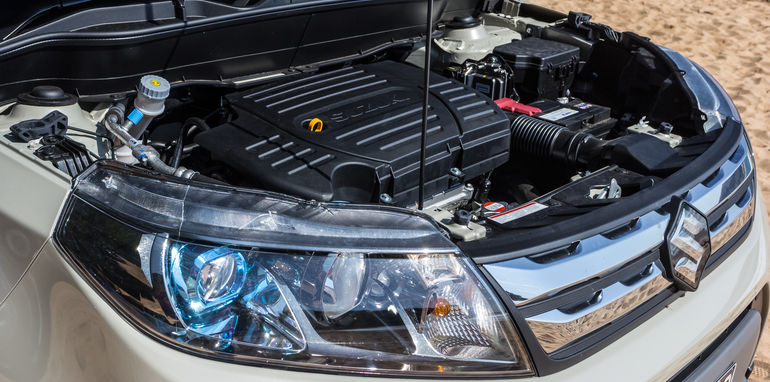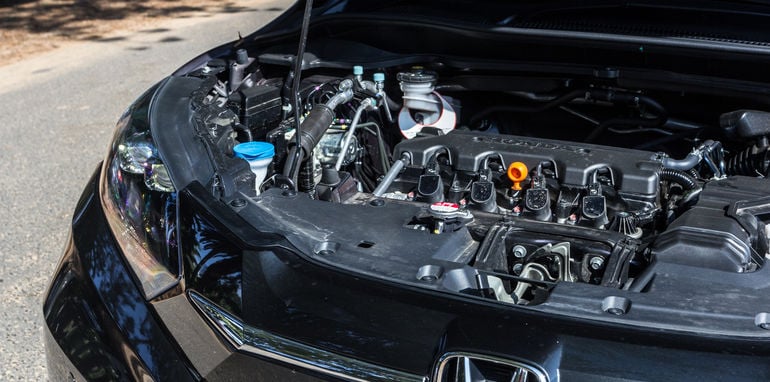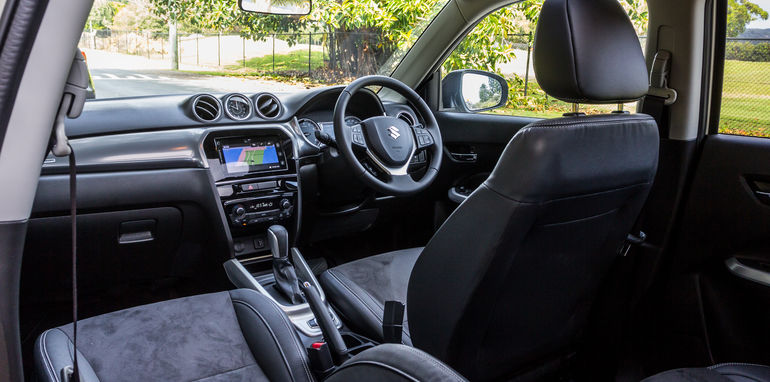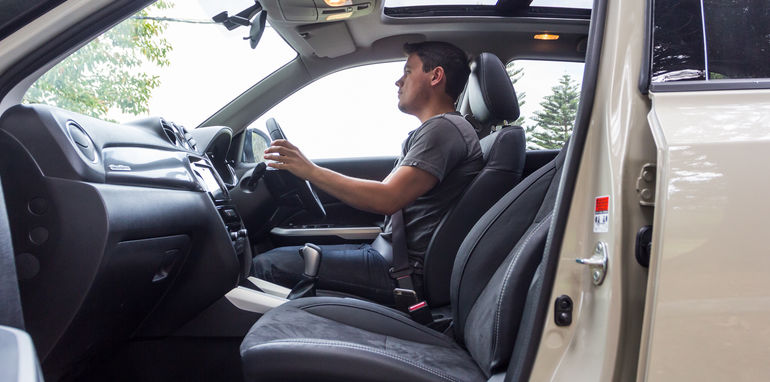ENGINE AND TRANSMISSION
The differences between the two powertrains extend beyond whether they drive or drag the rear wheels. The Honda pairs its Civic-sourced 1.8-litre four-cylinder petrol engine with a continuously variable transmission (CVT), and though the Suzuki inherits its smaller 1.6-litre four-cylinder petrol unit from the S-Cross, it trades that car’s CVT for a conventional (and superior) six-speed automatic.
Unfortunately, there’s no change in the engine’s peak outputs, which remain pinned at a modest 86kW of power at 6000rpm and 156Nm of torque at 4400rpm. The HR-V generates 22 per cent more power and 10 per cent more torque (105kW at 6500rpm and 172Nm at 4300rpm) – outputs that motivate this size of vehicle much more effectively.


The Vitara’s transmission does its best to keep the underpowered engine on the boil, though this means it’s regularly forced to grab or hang on to low gears for sustained periods. Even at quarter throttle the engine will rev beyond 4000rpm climbing urban hills, and consequently sounds noisy and strained. Fortunately, it’s next to silent at idle and relaxed at highway speeds.
The HR-V’s powertrain is more capable and refined. The engine’s extra power makes it feel more effortless than the Vitara, and like any good Honda motor it’s smooth right up to its redline. It forms a decent partnership with the CVT, which doesn’t flare or drone like some others of its breed, though it also doesn’t quite deliver the perky performance of some others in the class (Mazda CX-3 and Skoda Yeti, for example).
STEERING, RIDE AND HANDLING
The differences between the Honda HR-V and Suzuki Vitara continue when assessing their dynamic performance. The HR-V feels more substantial and planted due partially to its greater mass but also its greater inherent refinement – it simply feels like it’s screwed together more tightly. The Vitara, by contrast, can feel brittle and plasticky over poor roads.
The Honda’s extra sophistication manifests itself in other ways. The suspension is better at soaking up smaller ruts, and the cabin offers far more insulation from tyre, suspension and engine noise.
But the Vitara boasts qualities of its own that outshine the HR-V. Being lighter, it feels more agile, and its steering is far nicer. While the Honda’s steering is heavy (a nuisance around town) and baulks at bumps, the Suzuki’s is light, natural, keen and progressive – all excellent things. The Vitara also grips the road better thanks to its all-wheel-drive underpinnings and its Continental ContiEcoContact tyres that are superior to the HR-V’s Dunlop SP Sport Maxx rubber.
The HR-V’s softer suspension may provide more cushioning from small bumps, but over speed humps and higher-speed undulations its reactions are far more pronounced than in the Vitara, which settles quicker and remains more composed. The softer Honda rolls and bounces more at higher speeds where the Suzuki sits flatter. Still, the Vitara tends to shimmy over road joins and concrete surfaces, and can feel a little pitchy over patchy surfaces.
INTERIOR, INSTRUMENTS AND INFOTAINMENT
That sophistication gulf extends to the cabins. The Vitara flunks the age-old door thunk test, with its doors flopping into the half-closed position if you don’t give them a good tug or shove. During a wet week in Sydney, we also experienced water from the roof and door frames dribbling onto the front seats after opening the doors – another factor detracting from its perception of quality.
Its cabin materials don’t have the same quality feel to them, either. Cheap-feeling, hard plastics line the door panels and much of the dash, where the HR-V gets some nicer, soft-touch panels. There are some rough edges in the Vitara too, including where the roof liner meets the sunroof, and some wrinkly stitching on the leather seats.
But there’s plenty that makes the Vitara’s cabin a nice place to be, too. Colleague Matt and myself found its seats – both front and rear – more comfortable, while its suede seat base patches hold you better than the HR-V’s slippery leather.


VERDICT
The Honda HR-V and Suzuki Vitara may be far removed from the cars that debuted their badges last millennium, but with more conventional styling and packaging and loads more equipment, the new models are on the radars of far more shoppers than their predecessors could ever have dreamed.
Though they compete in the same segment, the HR-V and Vitara will appeal to vastly different buyers. Those prioritising advanced safety technology, powertrain performance, cabin quality and interior capaciousness will pick the Honda every time. Similarly, those after more engaging driving dynamics, the added ability of all-wheel-drive, greater visibility and comfort, and fresher styling inside and out will be best served by the Suzuki.
We believe both are better value in the cheaper trim levels rather than these high-end variants, and if you’re considering either, we’d recommend also looking at the Mazda CX-3 and Skoda Yeti, which are the best all rounders in the segment.
In this small SUV skirmish, however, it’s the Honda’s greater sophistication, substance and spaciousness that give it the edge over the Suzuki.

